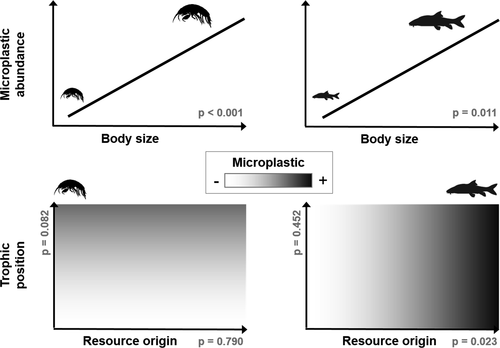当前位置:
X-MOL 学术
›
Environ. Sci. Technol.
›
论文详情
Our official English website, www.x-mol.net, welcomes your
feedback! (Note: you will need to create a separate account there.)
Stable Isotope Insights into Microplastic Contamination within Freshwater Food Webs
Environmental Science & Technology ( IF 10.8 ) Pub Date : 2021-01-07 , DOI: 10.1021/acs.est.0c06221 Flavien Garcia 1, 2 , Aline Reis de Carvalho 1, 2 , Louna Riem-Galliano 1 , Loïc Tudesque 1 , Magali Albignac 2 , Alexandra ter Halle 2 , Julien Cucherousset 1
Environmental Science & Technology ( IF 10.8 ) Pub Date : 2021-01-07 , DOI: 10.1021/acs.est.0c06221 Flavien Garcia 1, 2 , Aline Reis de Carvalho 1, 2 , Louna Riem-Galliano 1 , Loïc Tudesque 1 , Magali Albignac 2 , Alexandra ter Halle 2 , Julien Cucherousset 1
Affiliation

|
Microplastic pollution and ingestion are ubiquitous phenomena in freshwater ecosystems. However, our understanding of the role of trophic niche in microplastic ingestion is still limited. Here, we quantified the level of microplastic (700 μm to 5 mm) contamination for macroinvertebrates and fish within the Garonne river. We then used stable isotope analyses (δ13C and δ15N) to quantify trophic niches. We first demonstrated that the abundance of ingested microplastics differed between macroinvertebrates and fish and was not significantly related to microplastic pollution. We then found that microplastic characteristics (shape, color, size, and polymer composition) differ between the abiotic (surface waters and sediments) and biotic (ingested by macroinvertebrates and fish) compartments. The abundance of ingested microplastics increased with the size of organisms in both fish and macroinvertebrates and tended to increase with trophic position in macroinvertebrates only. Finally, the origin of the resources consumed by fish significantly affected the abundance of microplastics ingested. Altogether, these results suggest the absence of microplastic bioaccumulation in freshwater food webs and the dominance of direct consumption, most likely accidentally. The use of stable isotope analyses is therefore crucial to improve our understanding of microplastic ingestion by wild organisms.
中文翻译:

稳定的同位素洞察淡水食物网中的微生物污染
微塑料污染和摄入是淡水生态系统中普遍存在的现象。但是,我们对营养小生境在微塑性摄食中的作用的了解仍然有限。在这里,我们量化了加龙河内大型无脊椎动物和鱼类的微塑性(700μm至5 mm)污染水平。然后,我们使用稳定同位素分析(δ 13 C和δ 15N)量化营养小生境。我们首先证明,大型无脊椎动物和鱼类之间摄入的微塑料的含量不同,并且与微塑料污染没有显着关系。然后,我们发现非生物区(地表水和沉积物)和生物区(被大型无脊椎动物和鱼类所摄取)的微塑性特征(形状,颜色,大小和聚合物组成)不同。在鱼类和大型无脊椎动物中,摄入的微塑料的含量均随生物体大小的增加而增加,并且仅随着大型无脊椎动物的营养位置而增加。最后,鱼类消耗的资源的来源极大地影响了所摄入的微塑料的摄入量。共,这些结果表明,淡水食物网中没有微生物的生物蓄积性,而直接食用的优势很可能是偶然的。因此,稳定同位素分析的使用对于提高我们对野生生物摄入微塑料的理解至关重要。
更新日期:2021-01-19
中文翻译:

稳定的同位素洞察淡水食物网中的微生物污染
微塑料污染和摄入是淡水生态系统中普遍存在的现象。但是,我们对营养小生境在微塑性摄食中的作用的了解仍然有限。在这里,我们量化了加龙河内大型无脊椎动物和鱼类的微塑性(700μm至5 mm)污染水平。然后,我们使用稳定同位素分析(δ 13 C和δ 15N)量化营养小生境。我们首先证明,大型无脊椎动物和鱼类之间摄入的微塑料的含量不同,并且与微塑料污染没有显着关系。然后,我们发现非生物区(地表水和沉积物)和生物区(被大型无脊椎动物和鱼类所摄取)的微塑性特征(形状,颜色,大小和聚合物组成)不同。在鱼类和大型无脊椎动物中,摄入的微塑料的含量均随生物体大小的增加而增加,并且仅随着大型无脊椎动物的营养位置而增加。最后,鱼类消耗的资源的来源极大地影响了所摄入的微塑料的摄入量。共,这些结果表明,淡水食物网中没有微生物的生物蓄积性,而直接食用的优势很可能是偶然的。因此,稳定同位素分析的使用对于提高我们对野生生物摄入微塑料的理解至关重要。











































 京公网安备 11010802027423号
京公网安备 11010802027423号